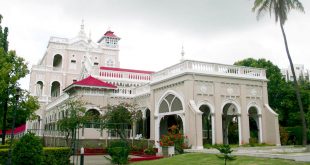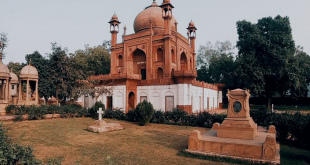Recognized as the ‘Baby Taj’, the tomb of Itmad ud Daulah is regarded to be an inspiration and motivation for the Taj Mahal. However, this monument is a much delicate construction with fine carvings and marble latticework screens. This is the initial Mughal structure built with marbles. This was also the initial of several tombs made on the peaceful banks of the Yamuna River. The tourists visiting Agra should not miss out on catching a glimpse of Itmad ud daulah’s tomb.
Contents
Tomb
The Itmad ud daulah tomb at Agra was built by the wife of Jehangir, Noor Jahan. This mausoleum is often considered to be a rough blueprint of the Taj Mahal. The style of this monument is more or less the same as that of the mausoleum created for Jehangir near Lahore in Pakistan.
The architecture of Itmad ud daulah has been appreciated by all the generations. The tomb’s structure is quite different in comparison to the early Mughal mausoleums made during this time. The importance of the itmad ud daulah is next to the Taj Mahal and the Agra Fort. The major features of this mausoleum that are quite popular all over the world are the – tomb chamber, marble screens, and pieta dura artworks.
History
The Itmad ud daulah history is very simple, yet quite interesting and appealing. Itimad-Ud-Daulah a.k.a Mirza Ghiyas Beg was a very poor Persian merchant. While traveling to India with his pregnant wife, a girl child was born to them. Due to their poorness and extreme lack of money to survive, the couple decided on abandoning the baby. However, the child’s wails compelled them to return and carry her along with them. The baby brought luck to the couple. Ghiyas Beg happened to get a caravan, which took him straightaway to the court of the Mughals. He landed up at Akbar’s court and turned into a member of the court. Soon he started serving Akbar as his treasurer.

After the death of Akbar in the year 1605, his son Jahangir reigned as the next Mughal Emperor. He made Ghiyas Beg his Wazir or Chief Minister. He also honored him with the popular title of Itmad-Ul-Daulah or the state’s pillar.
The daughter of Ghiyas Beg grew up and became an immensely beautiful woman. She started being recognized as Mehr-un-Nissa, the Sun of Womanhood. Words about the beauty of Mehr-un-Nissa spread, and she was soon married off. However, she turned into a widow in very less time and returned back to Jahangir’s court.
The beautiful Mehr-un-Nissa was very intelligent. She was extremely passionate and possessed strong administrative capability. She took up many responsibilities of the court and handled her every duty immensely well. She captured the curiosity and attention of Jehangir, who started liking her in no time.

In the year 1611, Jehangir got married to Mehr-un-Nissa. Soon, the lady became a very powerful figure in the court of Jehangir. She started being recognized as Noor Jahan or the Light of the World.
Itimad-Ul-Daulah breathed his last at Agra in the year 1622, some months after the death of his wife. After the death of her parents, Noor Jahan decided to get a marble tomb built in the loving memory of her father and mother. The Itmad ud daulah tomb was built between the years 1622 to 1628.

The structure’s main element is its resemblance to a beautiful jewel box placed in the center of the lavishly spread Itmad ud daulah tomb garden. The tomb showcases the personality and identity of the polished man buried there, and, more importantly, the ornamental and formal character of the builder Noor Jahan, who ruled over the entire Mughal Empire from behind her curtains for over 16 long years (1611 to 1627).
Architecture
The Itmad ud daulah architecture is an excellent instance of the mesmerizing architectural fashion incorporated in many ancient structures in Agra. The key element of this monument is its domb that is quite similar to the Persian architecture. This tomb is considered as the very first to incorporate the pietra dura fashion decoration, involving semi-precious stones. Every surface of this structure is beautifully decorated using motifs of trees, geometric structure, and flora, among others. Inlaid stone-based artworks are used for enhancing the outlasting beauty of this tomb’s interior.

The Itmad ud daulah ka maqbara is considered to be a beautiful platform tomb that was a quite popular design during the period of Jahangir’s rule. The tomb is made right outside the Agra wall. The tomb is built on a huge platform of red sandstone that can be easily accessed through four gateways of the monument. The tomb’s eastern gateway is the primary entrance, whereas the western one is the waterfront pavilion. The northern and southern gateways are basically pseudo gates that are constructed for maintaining symmetry. Every gate of the monument is built using red sandstone. The gates feature chine khana and geometric designs on pure, white marbles.

The main body of the Itmad ud daulah maqbara is basically square in shape and features four turrets that are crowned using tiny domed kiosks, known as Chattris. These chattris project from the corners of a big octagonal base. The tomb’s arched entrance is connected to the structures’ center and is generously filled with latticework. The mausoleum’s inner space is divided geometrically into a total of nine chambers. The central chamber of the tomb is the biggest of all. This space shelters the coffins of Itimad-Ud-Daulah and Asmat Begum. Pseudo cenotaphs are positioned on the monument’s second floor.

The central chamber of the tomb is only accessible through the southern gateway. The walls are painted with floral designs. Cypress tree decorations present here indicate the Persian influence on this monument. The walls also display the paintings of wine bottles. According to many famous literary works, these bottles showcase the intemperate drinking habit of Noor Jahan’s husband. The latticework originated from the Indian state of Gujarat. It was utilized intensively during the Mughal reign owing to its beauty as well as its capability of mutating natural light for enhancing the building’s carvings. Calligraphy design-based carved panels are present on both levels.
The tomb’s garden is nothing but a paradise in its true sense. The garden is square-shaped and is segregated into four portions with the help of water channels. The tomb is placed symmetrically at the meeting point of these four quadrants. There are a total of four rectangular-shaped pools inside the garden, along with beautiful fountains.
Ticket Price/Entry Fee
Itmad ud daulah ticket price is separate for Indian and foreign nationals.
- Indian nationals : INR 30 (weekdays), INR 25 (Fridays)
- Foreigner Nationals and NRIs: INR 310 (weekdays), INR 300 (Fridays)
- SAARC Countries(Bangladesh, Nepal, Bhutan, Sri Lanka, Pakistan, Maldives, and Afghanistan) and BIMSTEC (Bangladesh, Nepal, Bhutan, Sri Lanka, Thailand, and Myanmar): INR 30 (Weekdays), INR 25(Fridays).
- Video Camera Ticket: INR 25
Note: There is a provision of free entry for both Indian as well as foreign kids up to the age of 15.
Timings [Opening Hours]
The Itmad ud daulah timings for a visit are from sunrise till sunset. The monument opens at 6 AM and closes at 6 PM. One can pay a visit to this tomb on any day of the week as it is open on all days. However, it is highly recommended for the tourists to catch a glimpse of the monument during the time of sunset as the tomb basks brilliantly in the setting sun and looks much grander at this hour.
The most favorable time to visit the Itmad ud daulah Agra is from the month of October till the month of March. During this period the weather usually remains cooler and traveling, and sightseeing becomes a pleasant experience.
The climate of Agra is known for its harsh summers. So, if one is visiting the monument during summers then it is highly recommended to avoid going out during the afternoon as the weather happens to be very humid and extremely uncomfortable at this time. As the possibilities of dehydration due to excessive heat is common, it is suggested to take in enough fluids and keep the body hydrated at all times.
Location
The maqbara of Itmad-Ud-Daula is located along a broadly-paved path going from the Agra Fort to the Ram Bagh through the Ambedkar Bridge on the Yamuna River. To be more specific, the monument is situated in the Moti Bagh area of Agra, Uttar Pradesh. The Itmad ud daulah’s tomb distance from Taj Mahal is only 4 kilometers. The visitors can easily reach the tomb from any area of Agra via auto-rickshaw or taxi.
How to reach
You can reach Agra by air, road, or rail.
By Air
The closest international and domestic airport to Agra is the Indira Gandhi International Airport at Delhi. This airport is well-connected to all the primary foreign and Indian destinations. The tourists traveling via airways can take a bus, hire a taxi, or book a cab to reach Agra from the airport.
By Bus
Agra is well-linked with several towns and cities, such as Delhi, Gwalior, Kanpur, Lucknow, and Jaipur, through roadways. There are two major bus terminals, namely ISBT and Idgah Bus Stand. Here, buses are readily available for every major destination. The people driving from Delhi to Agra can take the NH 2 route whereas the ones driving from Jaipur can take the NH 11 route. Travelers can also take the Delhi-Agra Yamuna Expressway for a more pleasurable driving experience.
By Train
Agra is also well-connected to cities, such as Delhi, Jaipur, Gwalior, Kolkata, Mumbai, and Chennai, through regular trains. From Delhi, trains such as Punjab Mail, Up Sampark Kranti, Malwa Express, and Bhopal Express operate every day. After reaching the Agra railway station, the travelers can take a cycle-rickshaw or auto-rickshaw or book a prepaid cab to go to their destination.
If you are at the Agra Fort, the most preferred and highly recommended way of reaching Itmad-ud-Daulah tomb is taking a good shared auto-rickshaw or tuk-tuk from the Bijali Ghar Auto Stand near the fort. The Agra Fort to Itmad ud daulah distance can be covered in just thirty minutes.
If one is at the Taj Mahal, then he/she can first get a shared rickshaw from the Taj Ganj Auto Stand and ride to Bijali Ghar and then travel from there to the mausoleum in another auto-rickshaw.
Location Map
Things to do Around the Itmad-ud-Daulah Tomb
If you have visited and taken a good tour of the Itmad ud daulah tomb and have some more time left in your schedule to spend in Agra, you have a lot of amazing things to enjoy. You can take a cab to Chini ka Rauza and visit this beautiful historical monument that was built and dedicated to Shah Jahan’s Prime Minister Allama Afzal Mullah in the 17th century. The other nearby places that can be visited are – Ram Bagh, Mehtab Bagh, Moti Masjid, Sheesh Mahal, Musamman Burj, Jahangir Mahal, Jama Masjid, Anguri Bagh, and Bageshwarnath Temple.
Apart from visiting various monuments and temples and sightseeing, you can also indulge in relishing on the street foods of Agra. The highly recommended foods of this place, are – Petha, Paratha, Mughlai cuisines, Bhalla, Dalmoth, Tandoori Chicken, Jalebi, Shawarma, Paneer Tikka, and Bedai.
In addition to all the above-discussed activities, the tourists can also enjoy shopping in the streets of Agra near the Itmad ud daulah’s tomb. The most shopped for things in this place are – Leather Products (including bags, jackets, shoes, and belts), Marble Replicas (including ornamental boxes, vases, tabletops, plates, and statues), Carpets and Rugs, Jewelry, Silk Sarees, Embroidery Textiles, Handicrafts, Metal Wares (including flower vases, jewelry boxes, plates, and metal sculptures), Taj Mahal Souvenirs, and Sweets.
 Nerd's Travel Travel the World with Us!
Nerd's Travel Travel the World with Us!





